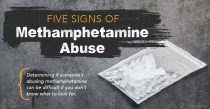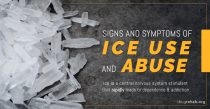
Determining if someone’s abusing methamphetamine can be difficult if you don’t know what to look for. Signs of methamphetamine abuse may include behavioral, paraphernalia, physical, financial, and social changes.
What Is Methamphetamine?
Methamphetamine (meth) is a highly addictive, man-made stimulant that commonly appears as a white powder, pill, or glass-like substance referred to as crystal meth. Meth has several street names including chalk, speed, tina, crank, fire, glass, go fast, and ice. Though it’s chemically similar to amphetamine, greater amounts of meth get into the brain, making it a more potent stimulant, as reported by the National Institute on Drug Abuse (NIDA).

Some of the most popular ways to abuse meth are to swallow, snort, inject, and smoke it. Long-term meth abuse can cause irreversible physical and emotional damage, and overdose can result in death. If you find out your loved one is abusing methamphetamine, it’s important to seek help. The following are five signs of methamphetamine abuse.
1. Behavioral Signs Of Methamphetamine Abuse
Methamphetamine can cause unusual behaviors like hyperactivity, euphoria, decreased appetite, paranoia, delusion, and increased energy or alertness. It’s also extremely difficult to sleep while on methamphetamine, and a meth binge can keep someone up for days.
The withdrawal symptoms when a person stops using the drug can cause insomnia, irritability, depression, anxiety, shaking, or fatigue.
Methamphetamine is also chemically similar to dopamine, and can make a person feel pleasure from the drug that can last all day. When the meth wears off, a person usually experiences a crash. According to NIDA for Teachers, “even small amounts of methamphetamine can cause a person to be more awake and active, lose their appetite, and become irritable and aggressive.”
Methamphetamine can also cause an overdose, which can lead to seizures, coma, and death. There are two types of meth overdose—acute and chronic, which are defined by the National Library of Medicine:
“An acute methamphetamine overdose occurs when someone takes this drug by accident or on purpose and has side effects. These side effects can be life-threatening. A chronic methamphetamine overdose refers to the health effects in someone who uses the drug on a regular basis.”
2. Paraphernalia Signs Of Methamphetamine Abuse
Methamphetamine abuse requires the use of paraphernalia, and other objects needed for abuse of the drug. To someone less familiar with the drug, these may seem strange or foreign.
Types of drug paraphernalia can include:
- Needles or syringes
- Aluminum foil
- Sandwich baggies with drug remnants
- Burnt metal spoons
- Light bulb used for smoking drug
- Straws
- Rolled-up dollar bills
- Tubes
- Smoking pipes
- Unexplained chemicals
Methamphetamine can be created in home labs using hazardous materials, as well as chemicals, that typically create an excessive amount of waste and byproduct. Methamphetamine ingredients may include alcohol, benzene, ether, red phosphorous, iodine, acetone, paint thinner, camp stove fuel, heet, ammonia, lye, drano, hydrochloric acid, propane cylinders, ephedrine, bronchodilators, and battery acid.
If you believe someone is conducting a meth lab, do not try to take the situation into your own hands, and don’t touch anything. To avoid serious injury and violence, it’s absolutely vital to contact authorities.

3. Physical Signs Of Methamphetamine Abuse
If your loved one has been abusing methamphetamine, they may start to show adverse physical changes. The physical signs of methamphetamine abuse can be pretty obvious, and may start with dilated pupils, droopy or twitching eyes, and excessive weight loss.
As a person continues abusing meth, they may experience further problems, including:
- Tooth decay (meth mouth)
- Frequent nose bleeds
- Chest pain
- Track marks
- Offensive body odors
- Skin lesions—open sores from picking and scratching
- Boils
- Abscesses
- Infections
- Premature aging
Some long-term health consequences of meth abuse may include
- Hypertension
- Destruction of muscles
- Kidney or liver failure
- Tachycardia
- Major mood swings
- Extreme paranoia
- Heart attack
- Hyperthermia
- Bronchitis
- Seizures
4. Financial Signs Of Methamphetamine Abuse
Abusing methamphetamine can cost a person more than their good health; it can cost them a small fortune. By comparison, meth is considered one of the cheaper drugs on the street, but still a person might spend all of their money to continue using the drug.
 Someone with a meth problem may constantly need to borrow money to fund their habit, even if they have a job. Friends and family members will do what they can to help their loved one, but sometimes without realizing they may be enabling them. Teenagers and students get a lot of their spending cash from parents, so as parents, it can be important to have an idea where that money’s going.
Someone with a meth problem may constantly need to borrow money to fund their habit, even if they have a job. Friends and family members will do what they can to help their loved one, but sometimes without realizing they may be enabling them. Teenagers and students get a lot of their spending cash from parents, so as parents, it can be important to have an idea where that money’s going.
Someone who’s suffering from an addiction to meth might not be able to pay back loans, pay medical bills, pay their rent and utilities, or pay for the general cost of living. Unfortunately, a person with a meth addiction may even resort to theft to pay for the drug.
5. Social Signs Of Methamphetamine Abuse
Methamphetamine abuse can also make a person extremely antisocial. Even when including themselves in social functions, a person suffering from methamphetamine abuse may not seem like themselves. It’s pretty common for someone with a meth addiction to push away old friends, and start hanging around those who are willing to accept their decision to use drugs.
If your friend or family member is struggling with an addiction to meth, please don’t give up on them. They need your love and support. But remember that you can be a friend to someone without giving them money, enabling, or accepting their drug addiction.
Sometimes the best thing you can do is turn the problem over to someone who better understands it—like the professionals at an addiction rehab center.
Find Treatment To Overcome Methamphetamine Abuse
If someone you love is battling an addiction to methamphetamine, contact us at DrugRehab.org. We can help you find the treatment you need to overcome methamphetamine. Your call will be completely confidential.
For More Information Related to “5 Signs Of Methamphetamine Abuse” Be Sure To Check Out These Additional Resources From DrugRehab.org:
- How Long Does Methamphetamine Stay In Your System
- Understanding The Combat Methamphetamine Act
- The Link Between Methamphetamine Addiction And Parkinson’s
- A New Weapon in The Meth Crisis
- Sepsis From Intravenous (IV) Drug Use
Sources
National Institute on Drug Abuse—What is Methamphetamine?
National Library of Medicine —Methamphetamine Overdose
NIDA for Teachers—Mind Over Matter: Methamphetamine (Meth)
NIDA for Teens—Methamphetamine (Meth)





